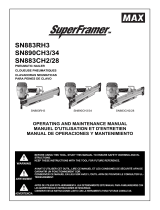
5
8. DO NOT TOUCH THE TRIGGER UNLESS YOU INTEND
TO DRIVE A FASTENER
Whenever the air supply is connected to the tool, never
touch the trigger unless you intend to drive a fastener into
the work. It is dangerous to walk around carrying the tool
with the trigger pulled, and this and similar actions should
be avoided.
9. NEVER POINT THE DISCHARGE OUTLET TOWARD
YOURSELF AND OTHER PERSONNEL
If the discharge outlet is pointed toward people, serious ac-
cidents may be caused when misfiring. Be sure the dis-
charge outlet is not pointed toward people when connecting
and disconnecting the hose, loading and unloading the fas-
teners or similar operations.
10. USE SPECIFIED FASTENERS
(SEE PAGE 7)
The use of fasteners other than specified fasteners will
cause the tool malfunction. Be sure to use only specified
fasteners when operating the tool.
11. PLACE THE DISCHARGE OUTLET ON THE WORK SUR-
FACE PROPERLY
Failure to place the discharge outlet of the nose in a proper
manner can result in a fastener flying up and is extremely
dangerous.
12. DO NOT DRIVE FASTENERS CLOSE TO THE EDGE
AND CORNER OF THE WORK AND THIN MATERIAL
The workpiece is likely to split and the fastener could fly free
and hit someone.
13. DO NOT DRIVE FASTENERS ON TOP OF OTHER FAS-
TENERS
Driving fasteners on the top of other fasteners may cause
deflection fasteners which could cause injury.
14. REMOVING THE FASTENERS AFTER COMPLETING
OPERATION
If fasteners are left in the magazine after the completion of
operation, there is the danger of a serious accident occur-
ring prior to the resumption of operation, should the tool be
handled carelessly, or when connecting the air fitting. For
this reason, always remove all fasteners remaining in the
magazine after completion of the operation.
15. CHECK OPERATION OF THE CONTACT TRIP MECHA-
NISM FREQUENTLY INCASE OF USING A CONTACT
TRIP TYPETOOL
Do not use the tool if the trip is not working correctly as ac-
cidental driving of a fastener may result. Do not interfere
with the proper operation of the contact trip mechanism.
16. WHEN USING THE TOOL OUTSIDE OR ELEVATED
PLACE
When fastening roofs or similar slanted surface, start fas-
tening at the lower part and gradually work your way up.
Fastening backward is dangerous as you may lose your foot
place.
Secure the hose at a point close to the area you are going
to drive fasteners. Accidents may be caused due to the
hose being pulled inadvertently or getting caught.
17. NEVER USE THE TOOL IF ANY PORTION OF THE TOOL
CONTROLS (e.g., TRIGGER, CONTACT ARM) IS INOP-
ERABLE, DISCONNECTED, ALTERED OR NOT WOK-
ING PROPERLY
18. NEVER ACTUATE THE TOOL INTO FREE SPACE
This will avoid any hazard caused by free flying fasteners
and excessive strain of the tool.
19. ALWAYS ASSUME THAT THE TOOL CONTAINS FAS-
TENERS
20. RESPECT THE TOOL AS A WORKING IMPLEMENT
21. NO HORSEPLAY
22. NEVER LOAD THE TOOL WITH FASTENERS WHEN
ANY ONE OF THE OPERATING CONTROLS (e.g., TRIG-
GER, CONTACT ARM) IS ACTIVATED











